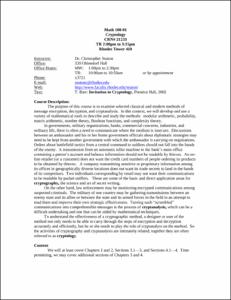Please use this identifier to cite or link to this item:
http://hdl.handle.net/10267/15779Full metadata record
| DC Field | Value | Language |
|---|---|---|
| dc.contributor.author | Seaton, Christopher | - |
| dc.date.accessioned | 2013-03-07T15:21:06Z | - |
| dc.date.available | 2013-03-07T15:21:06Z | - |
| dc.date.issued | 2011-01-12 | - |
| dc.identifier.uri | http://hdl.handle.net/10267/15779 | - |
| dc.description | This syllabus was submitted to the Office of Academic Affairs by the course instructor. Uploaded by Archives RSA Josephine Hill. | en_US |
| dc.description.abstract | The purpose of this course is to examine selected classical and modern methods of message encryption, decryption, and cryptanalysis. In this context, we will develop and use a variety of mathematical tools to describe and study the methods: modular arithmetic, probability, matrix arithmetic, number theory, Boolean functions, and complexity theory. In governments, military organizations, banks, commercial concerns, industries, and ordinary life, there is often a need to communicate where the medium is insecure. Discussions between an ambassador and his or her home government officials about diplomatic strategies may need to be kept from another government with which the ambassador is carrying on negotiations. Orders about battlefield tactics from a central command to soldiers should not fall into the hands of the enemy. A transmission from an automatic teller machine to the bank’s main office containing a patron’s account and balance information should not be readable by thieves. An on-line retailer (or a customer) does not want the credit card numbers of people ordering its products to be obtained by thieves. A company transmitting sensitive or proprietary information among its offices in geographically diverse locations does not want its trade secrets to land in the hands of its competitors. Two individuals corresponding by email may not want their communications to be readable by packet sniffers. These are some of the basic and direct application areas for cryptography, the science and art of secret writing. On the other hand, law enforcement may be monitoring encrypted communications among suspected criminals. The military of one country may be gathering transmissions between an enemy state and its allies or between the state and its armed forces in the field in an attempt to read them and improve their own strategic effectiveness. Turning such “scrambled” communications into comprehensible messages is the process of cryptanalysis, which can be a difficult undertaking and one that can be aided by mathematical techniques. To understand the effectiveness of a cryptographic method, a designer or user of the method not only needs to be able to carry through the steps of encryption and decryption accurately and efficiently, but he or she needs to play the role of cryptanalyst on the method. So the activities of cryptography and cryptanalysis are intimately related; together they are often referred to as cryptology. | en_US |
| dc.language.iso | en_US | en_US |
| dc.publisher | Memphis, Tenn. : Rhodes College | en_US |
| dc.relation.ispartofseries | Syllabi CRN;21233 | - |
| dc.rights | Rhodes College owns the rights to the archival digital objects in this collection. Objects are made available for educational use only and may not be used for any non-educational or commercial purpose. Approved educational uses include private research and scholarship, teaching, and student projects. For additional information please contact archives@rhodes.edu. Fees may apply. | - |
| dc.subject | Syllabus | en_US |
| dc.subject | Curriculum | en_US |
| dc.subject | Academic departments | en_US |
| dc.subject | Text | en_US |
| dc.subject | Mathematics and Computer Science, Department of | en_US |
| dc.subject | 2011 Spring | en_US |
| dc.title | MATH 108-01, Cryptology, Spring 2011 | en_US |
| dc.type | Syllabus | en_US |
| Appears in Collections: | Course Syllabi | |
Files in This Item:
| File | Description | Size | Format | |
|---|---|---|---|---|
| 2011_Spring_Math_108-01_21233.pdf | 60.59 kB | Adobe PDF |  View/Open |
Items in DSpace are protected by copyright, with all rights reserved, unless otherwise indicated.